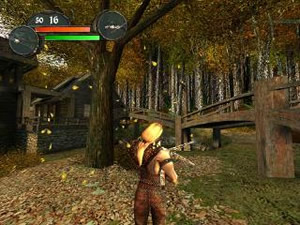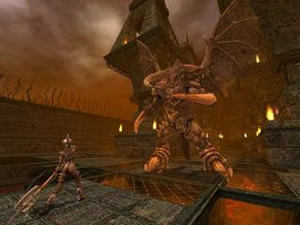Hack, slash, yawn.
Middle Earth is the place to be. Hell, even pointy-eared Leonard Nimoy would
rather dwell
in the land of elves and hobbits than spend another minute in the Alpha
Quadrant.
But it isn’t all fun in the sun with dew kissed mornings and elvish
weed aplenty. Nay – the ranks of good and evil always seem locked in neverending
combat. If it isn’t something about a ring or a sword, then it’s some catty
fight over who stole whose boyfriend.
And
so it goes that in the world of Enclave, the mystical city of Celenheim
has long been in turmoil as the forces of good and evil battle endlessly. A
great rift tore the earth apart, ending the war but dividing the world in two.
Now as the rift heals, the forces of light and dark are once again drawn together
and it’s up to you to sort out the mess.
The story boils down to a straightforward good guy/bad guy tale, but it’s not
very interesting, The epic rivalry between the Yooks
and Zooks is more insightful.
Enclave‘s third-person gameplay recalls the game Rune,
but the levels are harsh lessons in trial and error. The dual joystick controls
may prove a nuisance to those used to an automatic camera. There’s also an alternate
first-person mode, but it takes away from the sword fighting.
In a nice move, the game gives you two lengthy campaigns to play through, one
as the Light and one as the Dark. There are 12 playable characters split between
the two sides. The different classes each boast specific strengths and weaknesses.
For example, the knights/berserkers are best suited for melee fighting and have
enough strength to take a beating, whereas the weaker druids/liches wield long-range
magic. But despite the wealth of characters, they don’t have names or distinct
characters or, well, any sort of personality, which takes away from the already
thin story. Weird.
The melee fighting is nothing more than button mashing – tap once for an attack
and multiple times for a “combo.” What they really should have said was just
mash like a mofo. Attacks can be slightly varied by pressing directions with
your attack, but in a 3D environment in which you are using those same directions
to move around, your “varied attacks” end up as a crap shoot. The attacks really
need something more controlled and less random, like linking duck with an attack
for a special move. The only useful tactics are cycles of frenzied slashing
followed by backing away.
If melee isn’t your bag, then you can opt for bows and magical staves to sling
long-distance fury. You wouldn’t expect a traditional crossbow to come outfitted
with a sniping scope, so a clever aiming system has been implemented. Enemy
characters are indicated by a circular outline. By keeping your crosshair within
the enemies’ outline, you can target the enemy. The outline changes colors from
green to red as you maintain your aim to indicate the increased likelihood of
a successful shot. It’s intuitive and smart.
On your journeys, you’ll find pots of gold to nab and spend away on new supplies. Arming yourself for battle between each level is friendly on the wallet as you can sell back all of your purchases for their full value. Hence, there’s little risk in outfitting your character – just spend as much as you possibly can, because you’ll get it all back.
While this adds some variety, it doesn’t add as much depth as it professes.
Simply outfitting your character in as much as you can possibly buy doesn’t
take much in the way of strategic thinking. The only numerical differentiation
you’ll find in the weapons is a higher price tag; you never find out the specifics
of how much more damage different weapons do or if there is an adequate price
to value benefit from obtaining the weapon. The system is missing some very
basic, standard RPG qualities and it hurts.
 The
The
enemies you fight are powered by simple seek and destroy AI mechanics. There
are no discernible group tactics or anything beyond halfwitted goons giving
chase. At least enemies are able to venture beyond programmed boundaries, following
you across rooms and even up flights of stairs.
Enclave can be difficult, but largely for the wrong reasons. Instead
of focusing on honing skills, you inevitably fall prey to the trial and error
nature of the game. You’ll be playing this game on a strict level-by-level basis.
A bridge collapsed, drawing you into endless darkness? Okay, try again and
this time, jump OVER the bridge. Platform rock jumping over another endless
abyss? Doh! Try again. And again. And again. It can get frustrating, particularly
since you can’t save in the middle of a stage until the later levels. Screw
it up and you have to do the whole thing over again.
Still, the graphics are glistening, with sharply textured objects and intricate
details. The architecture and stone walls accurately convey the medieval theme.
The beautiful lighting and rich environments sometimes succumb to a noticeable
lapsed framerate, but by and large the game looks really good.
Enclave make good use of the 5.1 positional audio. It’s full of creepy
crawly sound effects, from the guttural moan of a tortured hellspawn to the
‘fwip’ of an arrow. The orchestral score is adequate, tempered to the nature
of the game rather than standing out.
And as a final note, the game has one of the most imaginative front ends I’ve ever seen, featuring a truly unnerving metal-bird thing that look like it was dragged flapping and squawking out of a Hellraiser flick. Neat.
Enclave isn’t a terrible game by any stretch. There’s a good deal on
the surface to enjoy. The metal bird, the beautiful graphics, the atmosphere…even
the title ‘Enclave’ whispers the promise of medieval fun. Unfortunately, the
promise is sadly broken. When you get past the surface, the random mash of melee
and the forced repetition of the levels chillingly weaken Enclave from
the inside out.

-
Engrossing detail and good graphics
-
Clever aiming system
-
Creepy metal bird front end
-
Weak combos and attacks
-
Simple enemy AI
-
Level to level trial and error
-
Not enough depth










